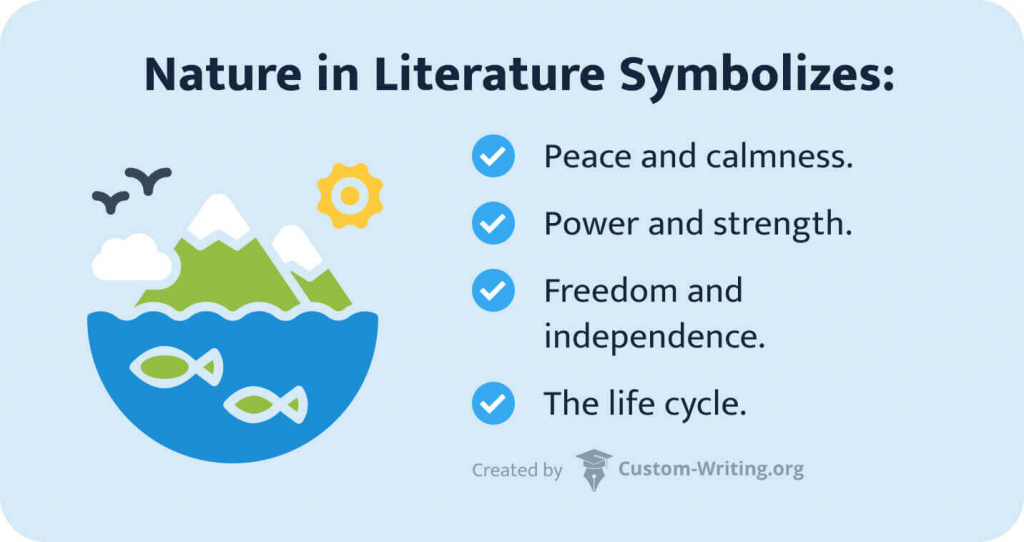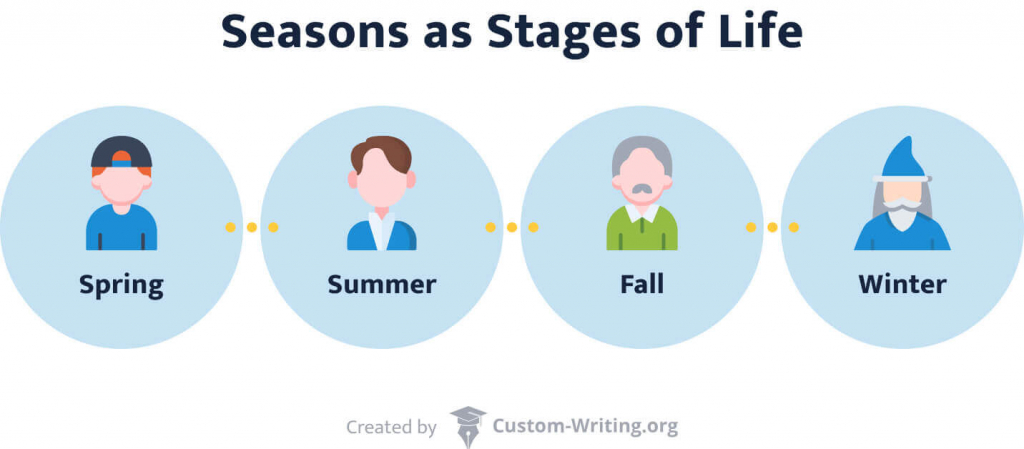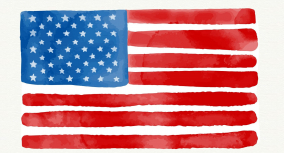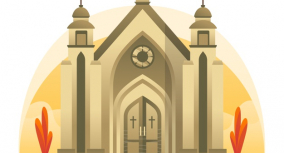You can find nature symbolism in literature across various cultures. It usually serves as the backdrop for the plot, helping the reader understand the story’s mood and flow. Mary Douglas, a renowned cultural anthropologist, suggested that nature symbolism is rooted in cultural systems, thereby carrying universal meanings.
This article, written by our custom writing experts, examines the most widespread nature symbols and their meanings in literary works:
- First, it explains what nature symbolizes in literature and discusses elements like the sky, sun, water, forest, and flowers.
- Further, it focuses on nature symbolism examples in famous literary works: Wuthering Heights, A Good Man is Hard to Find, Hamlet, Othello, and The Odyssey.
Each representation of nature in literature is thoroughly analyzed and accompanied by corresponding quotes.
🏞️ What Does Nature Symbolize?
Nature symbols may vary depending on the narrative. Nature can symbolize peace and calmness. Sometimes it also signifies power and strength. Some authors use it to represent the life cycle or show freedom and independence.

The symbolism of nature is deeply rooted in the past of humanity. Ancient people saw nature as a reflection of themselves, and they created myths to explain things they didn’t understand. The Earth, for example, could be a woman whose anger causes earthquakes.
Romanticism revived nature symbolism in art and literature, and it emphasized humans’ feelings, individuality, and its connection to nature. In the poetry of Byron, Coleridge, and Wordsworth, the romantic hero seeks to the heart of nature, trying to escape from a hostile society.
🌻 Nature Symbols and Their Meanings in Literature
When authors portray nature in the text, they usually depict its aspects, such as the sky, water, mountains, and plants. They all have different symbolic meanings depending on the context. Let’s take a closer look.
Sky Symbolism in Literature
The sky as a symbol usually means infinity and calmness. As the residence of gods, it may represent divine forces. In literature, it symbolizes different phenomena depending on the attribution:
- The clear blue sky shows happiness, joy, and serenity.
- The night sky symbolizes death and evil forces.
- Heavy clouds represent sadness or depression. Some authors use this symbol as a harbinger of unfortunate events.
In A Good Man is Hard to Find, the sky after a car crash is described as cloudless, symbolizing emptiness and calmness.
Water Symbolism in Literature
Water is one of the most ancient symbols. It takes different forms, so authors use its imagery to symbolize a great variety of things:
- Waterfalls, river streams, and raging waters are equated with power and strength.
- Boundless and uncontrollable oceans and seas usually symbolize chaos and danger.
- Being submerged in water frequently symbolizes rebirth. This symbol is closely connected to the rite of baptism that wipes away one’s sins.
In the novella The Old Man and the Sea by Ernest Hemingway, the sea symbolizes life with the struggles and challenges one faces throughout their existence.
Sun Symbolism in Literature
The sun is another ancient symbol that appears in every mythology. It brings warmth and gives life to everything on Earth. It may symbolize life and peace. Sometimes it represents power, God, or divine forces. Depending on the sun’s position, we may distinguish different symbolical meanings:
- The sunrise symbolizes hope, and the sunburst has the same symbolical meaning.
- The sunset means the end of the story or the life cycle.
In her novel The Outsiders, S.E. Hinton uses sunrises and sunsets as symbols. In the story, they represent the beauty and goodness of the world.
Forest Symbolism in Literature
A dark and misty forest is a typical setting for folklore stories and fairytales like Little Red Riding Hood, Snow White, Hansel and Gretel, and others.
- Going to the woods was always dangerous for humans, and people believed that dark forces and magic were hiding among the trees. That’s why it usually symbolizes mystery and danger.
- Sometimes a forest appears in literature as a symbol of freedom as the place one can hide in.
Trees also may have symbolic meaning:
- One of the most famous nature symbols is the tree of life, which connects all living creatures.
- Sometimes a tree symbolizes wisdom and knowledge, such as in the Garden of Eden story in the Bible.
In The Scarlet Letter, the forest becomes a symbol of freedom. It’s the place where the main characters, Hester and Dimmesdale, can hide from the strict puritan society.
Flowers Symbolism in Literature
Flowers in literature signify youth, beauty, and the brevity of life. In the Victorian era, people used the language of flowers to express their feelings secretly. Separately they may symbolize various human feelings, from love to hate. The meanings of different plants vary greatly depending on their type and color:
- Red roses are flowers meaning love.
- Daisy signifies family, fidelity, sweet simplicity, and tenderness.
- Lilies represent purity and innocence.
- Snowdrops are flowers meaning hope.
- Blue iris is the flower that symbolizes faith.
In The Chrysanthemums, John Steinbeck tells the story of a mature, strong woman whose only passion in life is taking care of her flowers. Her chrysanthemums symbolize her hidden femininity she cannot realize with her coldhearted husband.
Seasons Symbolism in Literature
Seasons are usually associated with changes. They can be used to represent the cycle of life, with each season symbolizing a different life stage. Sometimes authors use seasons to reveal different moods:
- Spring means the start of something new, love and youth.
- Summer symbolizes optimism, freedom, and hope.
- Fall is a setting for sadness and depression.
- Winter is the season of hopelessness, grief, and tiredness.

In The Great Gatsby, Fitzgerald uses different seasons to reflect the main characters’ mood. Summer is a season of new beginnings and hopes, love. Gatsby hopes to reunite with Daisy during this season, but his hopes die when fall starts. Fitzgerald uses fall as the symbol of death and grief. All tragic events, including the death of Gatsby, take place during this gloomy season.
Snow Symbolism in Literature
Snow and ice are frequently employed symbols in poetry and prose. Both of them are symbols of winter and cold, and each has additional symbolical meaning:
- Snow symbolizes purity and innocence, and sometimes it represents the beauty of a woman.
- Ice means coldness, rigidity, and absence of love.
For example, in Stopping by Woods on a Snowy Evening, Robert Frost describes snow to represent the purity, calmness, and tranquility of the place the speaker stopped by for a while on a cold winter day.
Rain Symbolism in Literature
A hero who walks under the rain is a popular image in literature. Let’s see what it can mean:
- Rain is commonly associated with feelings of loneliness and sadness. In this sense, it closely resembles tears.
- Rain also can signify cleansing. Symbolically rain washes away bad memories or the past of a character. A person passing through the rain undergoes a kind of inner transformation.
J. D. Salinger in The Catcher in the Rye uses rain to show the transformation of the main character. In the final scene with the carousel, the rain symbolizes Holden’s cleansing of his eternal discontent and grumbling.
📚 Symbolism of Nature in Literature: Examples
Since the use of symbolism of nature is varies depending on the context, we have prepared an analysis of several famous examples of world literature. This analysis will give you a complete comprehension of how authors use images of nature in their works.
Wuthering Heights: Moors Symbolism
In her only novel Wuthering Heights, English writer Emily Bronte tells the tragic love story of a foundling orphan and the daughter of his adoptive parents. One of the crucial elements of the novel’s composition is the landscape. The story’s central location is moors—wild and infertile land areas.
- The moors are presented as dangerous and empty. We can feel the danger in the hesitation of the narrator walking through them at night.
- Bronte also uses moors as a symbol of freedom and wildness. Catherine and Heathcliff run away from everyone to the heather fields, and there, in unity with nature, they find love and harmony:
But it was one of their chief amusements to run away to the moors in the morning and remain there all day, and after the punishment grew a mere thing to laugh at.
Wuthering Heights, Nelly Dean, Chapter VI
For Heathcliff, the moors also become an endless reminder of Catherine’s death. The entire Wuthering Heights for him turn into Catherine’s ghost:
In every cloud, in every tree—filling the air at night, and caught by glimpses in every object by day—I am surrounded with her image.
Wuthering Heights, Heathcliff, Chapter XXXIII
You can find more interesting info in our Wuthering Heights analysis.
A Good Man is Hard to Find: Sky Symbolism
In her famous story A Good Man is Hard to Find, Flannery O’Connor describes the sky after a car crash as empty with no clouds or sun. The sky’s emptiness parallels the state of desolation that the Bailey family members feel at the end of the story:
There was not a cloud in the sky nor any sun.
A Good Man, Narrator
At the same time, the clear sky contrasts the events taking place. It is frightening that a terrible crime is committed on a fine and bright day. The author used this literary device to highlight the severity of Misfit’s crime.
When Misfit kills the last surviving family member, the grandmother, she smiles. At this very moment, the cloudless sky starts to represent the peace that the grandmother found at her last moment:
Hiram and Bobby Lee returned from the woods and stood over the ditch, looking down at the grandmother who half sat and half lay in a puddle of blood with her legs crossed under her like a child’s and her face smiling up at the cloudless sky.
A Good Man, Narrator
If you’re interested in Flannery O’Connor’s use of symbols and other literary devices, check out our analysis of A Good Man is Hard to Find.
Unweeded Garden & Symbolism of Flowers in Hamlet
Shakespeare uses flower imagery numerous times throughout Hamlet. One example is the titular character describing Denmark’s state by comparing it with a poorly maintained garden:
Fie on ’t, ah fie! ‘Tis an unweeded garden
Hamlet, Hamlet, Act 1, Scene 2
That grows to seed. Things rank and gross in nature
Possess it merely.
Another example is Ophelia giving flowers to the court to express her sorrow and grief. These are the meanings of flowers she brings:
- Rosemary is a symbol of memory and faith. She gives this flower to her brother Laertes to strengthen his spirit and the memory of his father.
- Pansies symbolize thoughts and memories. Ophelia gives them to her brother Laertes to show that she will never forget him.
- Fennel symbolizes flattery, and columbine means adultery and betrayal in the language of flowers. Ophelia gives fennel and columbine to the king, holding him responsible for the death of her father, Polonius.
- Rue’s symbolism is tied with adultery, and she gives it to the Queen, accusing her of her father’s betrayal.
- Daisy means purity and innocence, and that is why Ophelia doesn’t give it to anyone as “there is no innocence here.”
- Dead man’s finger, nettle, crow-flowers are traditionally used in funeral rituals.
- Daisies signify the unhappy love between Ophelia and Hamlet.
Later we learn from the Queen’s words that Ophelia died trying to hang her flower garlands on the trees:
There were fantastic garlands did she come
Hamlet, Queen Gertrude, Act 4, Scene 7
of crow-flowers, nettles, daisies, and long purples
that liberal shepherds give a grosser name,
but our cold maids do dead men’s fingers call them.
Another flower used prominently in Hamlet is a violet representing the brevity of life. We can see violets symbolism on several occasions, including Ophelia’s funeral and the dialog between her and Laertes. The latter compares Hamlet’s feeling for Ophelia to a violet, hinting that it will pass as quickly as this flower fades:
A violet in the youth of primy nature,
Hamlet, Laertes, Act 1, Scene 3
forward, not permanent, sweet, not lasting,
the perfume and suppliance of a minute.
Animals Symbolism in Othello
In one of Shakespeare’s most famous tragedies, Othello, animal symbols can be found throughout the whole narrative:
- Iago tells Brabantio about Othello and Desdemona and describes them as animals to highlight the contrast between them: “an old black ram is tupping your white ewe.” Iago hints that Othello is an outsider who does not deserve such a pure creature as Desdemona.
- He refers to Othello as a “Barbary horse.” With these words, Iago wants to disgust Desdemona’s father with the idea of such a couple:
Because
Othello, Iago, Act 1, Scene 1
we come to do you service and you think
we are ruffians, you’ll have your daughter
covered with a Barbary horse. You’ll have
your nephews neigh to you.
- Before his death, Rodrigo calls Iago an “inhuman dog” to show awareness of his evil plans.
- Othello describes Iago as a snake and calls him a “viper.” In this word, we can easily find the poison imagery that emphasizes the damage Iago caused to Othello.
- Shakespeare also uses animal imagery to reveal Iago’s cruelty. This phrase shows him as a coldhearted and cynical man who ignores love:
Ere I would say I would drown myself for the love of a guinea hen,
Othello, Iago, Act 1, Scene 3
I would change my humanity with a baboon.
Animals in Othello mainly appear as insults or as an allusion to inferiority. It fits with the medieval concept of The Great Chain of Being— a social hierarchy with God on the top and minerals at the bottom. As humans in the chain hold a higher position than animals, describing a man as a beast may be considered humiliating. You can learn even more about these symbols from our article on imagery in Othello.
Symbolism of the Sea in The Odyssey
In The Odyssey, the poem by ancient Greek poet Homer, the sea is the central landscape of the narration. The story follows the adventures of a mythical hero named Odysseus during his return to his family after the Trojan War ended. Odysseus travels by sea and faces challenges that prevent him from returning home.
- The core meaning of the sea in The Odyssey is a life path with victories and defeats. At the end of this incredible journey, Odysseus gains wisdom and strength.
- Another meaning of the sea is danger and the weakness of humans before gods. As Odyssey unknowingly angers the sea god Poseidon by punishing his son, the Cyclopes, he creates a storm to send Odysseus off course:
As he said this,
The Odyssey, Narrator, Book 5
a massive wave charged at him with tremendous force,
swirled round the raft, then from high above crashed down.
The sea also hides monsters Charybdis and Scylla in the narrow channel which Odysseus has to cross. He is caught between two evils and decides which one he should pass, and he chooses Scylla as it is less dangerous than Charybdis:
I did not mention Scylla—for she was
The Odyssey, Odysseus, Book 12
a threat for which there was no remedy—
in case my comrades, overcome with fear,
stopped rowing and huddled up together
inside the boat.
Even though the sea has become the source of many dangers, Odysseus managed to return to Ithaca, which symbolizes home. You can learn more about the poem’s imagery from our article on symbolism in The Odyssey.
We hope that our explanation of different nature symbols will help you see your favorite literary works in a new light. If you liked our article, you’re welcome to share it or leave a comment. We are always happy to receive your feedback!
❓ Nature Symbolism
What Symbolism Is Associated with Nature and the Forest?
Nature and forests often symbolize rejuvenation, freedom, and mystery. They represent life cycles, growth, and renewal. Forests can also embody the unknown or subconscious, offering a space for introspection and transformation in various literary and cultural contexts. Dark trees in the forest are usually associated with bleakness and hidden danger that the main character has to overcome.
Why Did Early Authors Use Nature as Symbolism?
Early authors personified nature because they found their inspiration in myths and folklore. Nature as a symbol has been represented in art since the Renaissance period. European authors used different nature symbols to contrast the romantic hero and society.
What Does Nature Symbolize in The Scarlet Letter?
In The Scarlet Letter, the author uses nature to reveal the theme of individual vs. society. The central nature symbol is the forest. For Esther, the alluring paths of the forest embody the way to freedom. Her daughter Pearl also feels free in this natural element.
What Does Nature Symbolize in Frankenstein?
The most prominent nature symbol in Frankenstein is ice. It represents isolation, alienation, and a lack of the warmth of human companionship. Victor’s pursuit of the monster across the frozen north symbolizes his alienation from society, resulting from his dangerous experiments.
What Role Does Nature Play in the Symbolism of the Novel Of Mice and Men?
Lennie’s character symbolizes nature, as his power and innocence bring him closer to animals rather than people. A friendship between George and Lennie can be interpreted as a relationship between humans and nature. In this context, the novel shows the development of the relationship between man and nature with the symbolic death of the latter.
🔍 References
- Natural Symbols: Explorations in Cosmology by Mary Douglas
- Water Symbolism: Wiley Online Library
- Flowers in Mythology: Encyclopedia.com
- What Does Snow Symbolize? Symbolic & Spiritual Meaning of Snow: Reference
- Conventional Symbols in Literature: Deer Valley Unified School District
- Examples of Seasonal Symbolism: Pen and the Pad
- Flower Meanings: The Language of Flowers: Almanac
- The Moors as a Reflection of Catherine and Heathcliff: Baylor University
- Shakespeare’s Favorite Flowers: The Violet: Shakespeare Birthplace Trust
- Shakespeare’s Blush, or “the Animal” in Othello: CUNY
- The Sea Voyage Motif in Imaginative Literature: Southwestern Oklahoma State University
- Making the Weather in English Writing and Art: The Guardian











